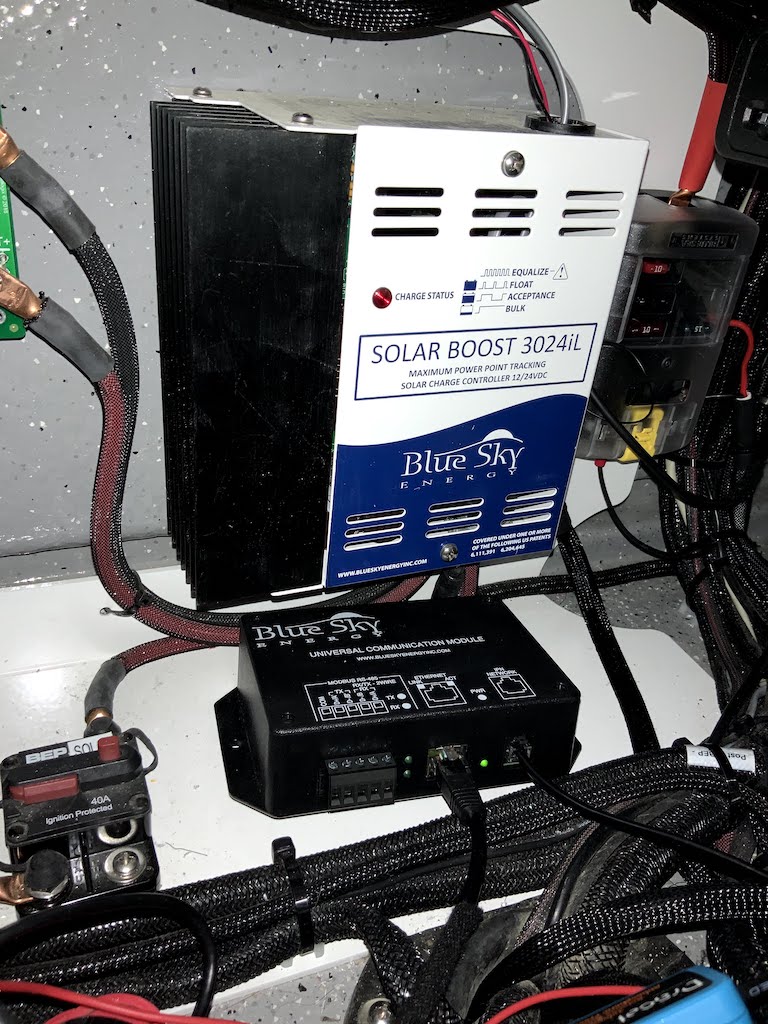Molly has three solar panels located on her roof. In theory these combined can generate 154 x 3 or 462 watts of energy. This is under ideal conditions, and we have never generated this much power. Or have we?
Molly came with a Blue Sky Energy Solar Boost 3024iL MPPT solar charger with its IPN Remote. We added to this setup a Universal Communication Module (UCM), also from Blue Sky Energy. The UCM allows us to connect our computer to the Solar Charger and monitor energy generation and charging mode. And answer the question of how much our panels are actually generating.
Solar charging can be a fickle business, and understanding how much green solar energy we are making is our objective. Knowing how much generation we have helps us to understand how to manage our batteries.
Wiring Up
The UCM needs about 1 watt to run and gets its power from the Master Solar Charger via a 4 core IPN Network cable. This cable is merely a standard 4-pin telephone cable. The UCM is connected to the network via the RJ45 ethernet cable. It took a little fiddling to change the factory set IP address, but once done, the UCM presented nicely on our local network. The UCM also has a RS485 connection, but the ethernet connection is a little more powerful, as it also presents a web interface for a browser and an ftp interface to download files. So, this is the direction we initially went. But now that it is all setup and working, we will change to RS485, so we cab free up an ethernet port on our router.
The Raspberry Pi connects to the UCM via node-red and a TCP based MODBUS adaptor. Configuration was unusually easy, and took less than 10 minutes to configure.
Although there are many variabes we can monitor, we are only monitoring the following
- Charge State. Off, Absorption, Float, Equalize or Bulk
- Battery Volts
- Output Amps from Controller
We might add more parameters later, but these are the key ones for now.
Early Results
We have only had 2 days of test so far. On a bright sunny day we can generate about 5 times our base load. Our base load is about 65 watts, and we can generate about 330 watts. Not quite the promised 452 watts. But this is 73% of the rated output for the solar panels, so we are in the expected ballpark.
In theory we should be able to recover most of the power lost during the night during the following day, assuming a a nice sunny day with a good view of the sky.
Further Monitoring
Further testing in a variety of different conditions, revealed similar results to that mentioned above. In sunny conditions we recover each day. If the sky is overcast, or we are parked under the shade of a tree or if snow is covering the roof, then the solar panels have no hope. Even if we added more solar panels to the roof, it is unlikely they would help much. It is hard to make hay when the sun ain’t shining.
Changing our Solar Generation
The monitoring system has led us to a conclusion that we need to change two things. More solar panels and more battery capacity. More solar panels for conditions when getting access to the sun is hard and more battery capacity for when the accessing the sun is very hard.
The batteries were upgraded from 540 Ahr AGMs to 600 Ah lithiums. Even with no sun, this increased battery capacity should last around 3 days.
We added two portable panels each 120 watts from Bluetti (SP120), which we can move around depending on where the sun is. We went with portable vs roof mounted, because the roof might be in the shade. The new panels need their own solar charge controller, and we choose the Blue Sky Energy Solar Boost 1524iX.
There is much more detail on upgrading the batteries and adding portable solar on the section on Solar and Batteries.
Solar Generation Monitoring
The state of charge of the batteries is very linked to the solar generation. And knowing exactly how the solar generation changes throughout the day or across the seasons helps understand the generation and thus the state of the batteries. We try to use solar as much as possible to maintain the batteries and their state of charge.
Adding the Universal Communication Module to allow solar generation data to be acquired was one of our better ideas.





